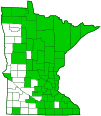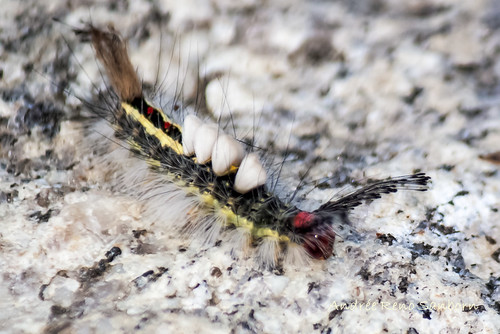white-marked tussock moth
(Orgyia leucostigma)
Conservation • Description • Habitat • Ecology • Distribution • Taxonomy
|
||||||||
| Hodges # | 8316 |
|||||||
Conservation Status |
||||||||
| IUCN Red List | not listed |
|||||||
| NatureServe | N5 - Secure |
|||||||
| Minnesota | not listed |
|||||||
Description |
||
White-marked tussock moth is a small, short-lived, late-season moth. It is common in the United States east of the Great Plains and in adjacent Canadian provinces. Sightings in the west and in Mexico are few and scattered. Adults emerge in late August to early October. They are ⅝″ to ⅞″ (15 to 22 mm) long with a wingspan of 1″ to 1⅜″ (25 to 35 mm). They have vestigial mouthparts and do not feed. They live just a few weeks and are gone by mid-October. The female is grayish-white to light brown and ½″ to 9 ⁄16″ long (12 to 14 mm). It does not have wings. The forewing of the male is dark grayish-brown with a thin, sharply defined, dark line that separates the basal and median areas (antemedial or AM line) and another that separates the median and post-medial areas (postmedial or PM line). These lines are often edged with wide brown bands. There is a bold white crescent on the subterminal line near the inner margin. The hindwing is dark brown. The antennae are plumose and conspicuous. The caterpillar is distinctively marked and easy to recognize. The head is bright red. The abdomen has a broad black stripe in the middle (middorsal) flanked a broad bright yellow stripe on each side (subdorsal). There is a tuft of erect, white, gray, or yellowish hairs on each of the first through fourth abdominal segments (A1–A4). Segments A6 and A7 each have a small, bright red gland on top. Mature caterpillars are about 1⅜″ (35 mm) long. |
||
Size |
||
Total length: ⅝″ to ⅞″ (15 to 22 mm) Wingspan (male): 1″ to 1⅜″ (25 to 35 mm) |
||
Similar Species |
||
Habitat |
||
Fields, woodlands, and forests |
||
Ecology |
||
Season |
||
One generation in the north: Late August to early October |
||
Behavior |
||
Caterpillars disperse by ballooning. The spin a long thread of silk and let go of the plant they are on, letting the wind or breeze carry them to a new location. Most do not survive the process, succumbing to predators or to starvation when they land on a site that is inhospitable. Early stage (instar) larvae eat soft leaf tissue. Later stage caterpillars eat everything on the leaf but the main veins. Caterpillars have two bright red glands on the abdomen and have been observed drawing their long hairs (setae) over the glands. The glands may produce a poison to deter predators. Whether that is true or not, it is known that contact with the setae to sensitive skin, as on a person’s back, stomach, or inner arm, can cause an allergic reaction. |
||
Life Cycle |
||
Mating occurs on the top of the empty cocoon from which the female emerged. She lays a mass of up to 300 eggs right there, usually on the cocoon, covers them with froth, and soon dies. The eggs overwinter and hatch in the spring. |
||
Larva Hosts |
||
Leaves of deciduous and coniferous trees and shrubs |
||
Adult Food |
||
Adults do not feed |
||
Distribution |
||||
|
Sources |
|||
| 8/1/2022 | ||||
Occurrence |
||||
Very common |
||||
Taxonomy |
|||
Order |
Lepidoptera (Butterflies and Moths) | ||
Superfamily |
Noctuoidea (Owlet Moths and Allies) | ||
Family |
Erebidae (Underwing, Tiger, Tussock, and Allied Moths) | ||
Subfamily |
Lymantriinae (Tussock Moths) | ||
Tribe |
Orgyiini | ||
Genus |
Orgyia | ||
Subordinate Taxa |
|||
white-marked tussock moth (Orgyia leucostigma intermedia) white-marked tussock moth (Orgyia leucostigma leucostigma) white-marked tussock moth (Orgyia leucostigma oslari) white-marked tussock moth (Orgyia leucostigma plagiata) white-marked tussock moth (Orgyia leucostigma sablensis) |
|||
Synonyms |
|||
Hemerocampa leucostigma |
|||
Common Names |
|||
white-marked tussock moth |
|||
Visitor Photos |
|||||
Share your photo of this insect. |
|||||
| This button not working for you? Simply email us at info@MinnesotaSeasons.com. Attach one or more photos and, if you like, a caption. |
|||||
Alfredo Colon |
|||||
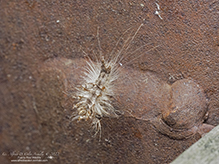 |
|||||
S. Boggie & B. Sweet |
|||||
Found on raspberry plants |
|||||
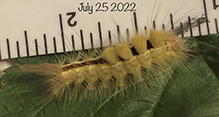 |
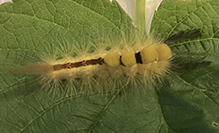 |
||||
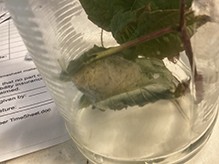 |
|||||
Laura Baxley |
|||||
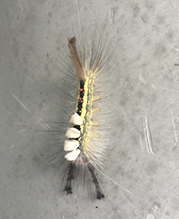 |
 |
||||
MinnesotaSeasons.com Photos |
|||||
|
|||||

Visitor Videos |
|||
Share your video of this insect. |
|||
| This button not working for you? Simply email us at info@MinnesotaSeasons.com. Attach a video, a YouTube link, or a cloud storage link. |
|||
Leah Starks |
|||
| white-marked tussock moth (Orgyia leucostigma) Published on Jul 5, 2019 |
|||
About
seen in early July at Red Oak Park in Burnsville, MN |
|||
Other Videos |
|||
| Orgyia leucostigma 06-21-18 wapogipofrog88 |
|||
About
Published on Jul 16, 2018 |
|||
| White-marked Tussock Moth Orgyia leucostigma Roy R |
|||
About
Published on Apr 8, 2018 Family: Erebidae Subfamily: Lymantriinae Identification: Similar to Orgyia definita. Females of these species can only be distinguished by identifying associated males. Wings usually grayer in male of this species median area usually paler. Blackish patch near apex smaller, with no light streaks below it. White spot accents lower st. line, as in male Orgyia definita. Wing Span: 2.5-3.5 cm (male). Female lacks wings. Life History: Sometimes a pest on Christmas tree plantations northward in its range. Flight: June-November (2 broods usually June-August and August-November). One brood (August-October) in far northeastern range. Caterpillar Hosts: Over 140 known hosts, including alder, apple, balsam fir, birches, and larch. |
|||


Created: 7/6/2019
Last Updated:
